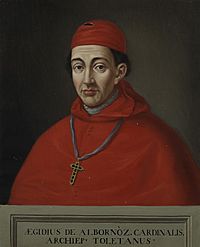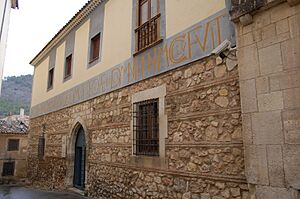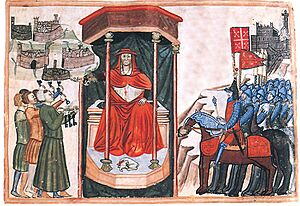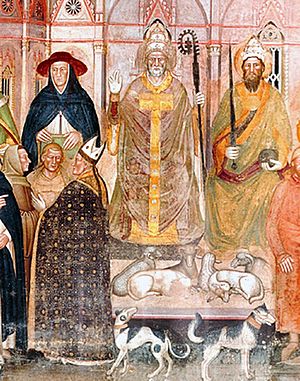Gil Álvarez Carrillo de Albornoz facts for kids
Quick facts for kids Gil Álvarez Carrillo de Albornoz |
|
|---|---|
| Cardinal-Bishop | |

Cardinal Gil de Albornoz in the painting by Matías Moreno, owned by the Museo del Prado, kept at the Real Academia de la Historia in Madrid
|
|
| Church | Roman Catholic Church |
| Archdiocese | Toledo |
| Province | Toledo |
| Orders | |
| Consecration | 17 December 1350 |
| Personal details | |
| Birth name | Egidio Álvarez de Albornoz y Luna |
| Born | c. 1295/1310 Carrascosa del Campo, Crown of Castile |
| Died | August 23, 1367 (aged 56–57) Viterbo, Papal States |
| Buried | Chapel of San Ildefonso 40°2′10″N 2°44′12″W / 40.03611°N 2.73667°W |
| Nationality | Spanish |
| Coat of arms |  |
Gil Álvarez Carrillo de Albornoz, often called Gil de Albornoz, was an important Spanish church leader and statesman. He was born around 1295-1310 and died on August 23, 1367.
He served as the Archbishop of Toledo from 1338 to 1350. Later, he became a Cardinal, which is a high-ranking official in the Roman Catholic Church. He was also a skilled military leader, guiding armies to regain control of lands for the Pope in Italy.
Albornoz was born in Carrascosa del Campo, Spain. He studied law in Toulouse, France. As Archbishop, he held important meetings to improve the church. He also showed his military skills by fighting against an invasion from Morocco in 1340 and helping capture the city of Algeciras in 1344.
In 1350, Pope Clement VI made him a cardinal. Later, Pope Innocent VI sent him to Italy to restore the Pope's power in the Papal States. He led successful campaigns, expanding the Pope's territories. He also created important laws for the Papal States called the Constitutiones Sanctæ Matris Ecclesiæ.
Even after many years of fighting, Italy remained unstable. However, Albornoz was honored for his service. He also founded the College of Saint Clement in Bologna in 1364, which was a school for students from Spain and Portugal.
Contents
Life and Career
Early Years and Education
Gil de Albornoz was born in Carrascosa del Campo, Spain, around 1302 or 1303. His father was Garcialuarez Albornoz, a lord and tutor to the future King Alfonso XI of Castile. His mother, Doña Teresa de Luna, was the sister of the Archbishop of Toledo.
He grew up and was educated in Zaragoza. He later studied law in Toulouse, France.
Church and Military Service
Albornoz became the Archbishop of Toledo in 1338, taking over from his uncle. He held two important church meetings (synods) in Toledo and Alcalá to make reforms.
He was also a brave military leader. In 1340, he fought successfully against an invasion from Morocco in the battle of Río Salado. In 1344, he led his archbishopric's army in the capture of Algeciras.
In 1343, he traveled to Avignon, where the Pope lived at the time, to ask for money from the Church to support a crusade.
Becoming a Cardinal
After King Alfonso XI died in 1350, Albornoz left Spain and never returned. In December 1350, Pope Clement VI recognized his skills and made him a cardinal-priest of S. Clemente. He then resigned from his role as Archbishop of Toledo.
In 1352, Pope Innocent VI appointed him as the Grand Penitentiary, a high position in the Church. He was even called the "Angel of Peace," though this title became ironic given his future military actions.
Campaigns in Italy
Restoring Papal Authority
In 1353, Pope Innocent VI sent Cardinal Albornoz to Italy. His mission was to bring back the Pope's control over the Papal States, which were lands ruled by the Pope. He led a small army of hired soldiers.
He gained support from powerful cities like Milan, Pisa, Florence, and Siena. He then began a campaign against Giovanni di Vico, a lord who had taken over many papal territories. Albornoz defeated Giovanni in 1354, and Giovanni signed a treaty to submit to the Pope. Albornoz then started building a palace in Viterbo to show his authority.
Expanding Papal Lands
Albornoz continued his campaigns in other regions of Italy, including the Marche and Romagna. He fought against powerful families like the Malatesta of Rimini and the Ordelaffi of Forlì. His forces were successful, and many families and cities, including Urbino, Ravenna, Senigallia, and Ancona, submitted to the Pope.
By late 1356, Albornoz was appointed as the bishop of Sabina, another important church title.
Establishing Laws
In 1357, Albornoz was called back to Avignon. Before leaving, he held a meeting with all the papal leaders. On April 29, 1357, he issued the Constitutiones Sanctæ Matris Ecclesiæ. These were important laws that organized the Papal States and divided them into provinces. These laws remained in effect for centuries, until 1816.
Second Campaign and Later Life
When Albornoz returned to Avignon, he was honored as Pater Ecclesiæ (Father of the Church). However, he soon had to go back to Italy because some lords were threatening the Pope's newly won lands. Albornoz made an agreement with a famous mercenary leader, forcing the Ordelaffi family to surrender in 1359.
Albornoz aimed to bring Bologna under papal control. When the city was attacked by Bernabò Visconti of Milan, its ruler handed it over to Albornoz. Meanwhile, Pope Innocent VI died, and Pope Urban V was elected. Albornoz continued his military efforts against Visconti.
Despite his hard work, the decade of warfare led by Albornoz did not bring complete peace to Italy. Mercenary groups continued to cause trouble. However, as a sign of thanks for his service, Pope Urban V appointed him as a legate (a papal representative) in Bologna in 1367. Sadly, Albornoz died in Viterbo that same year. His body was taken to Toledo, Spain, where he was buried with great honors.
Legacy
Cardinal Albornoz left a lasting impact beyond his military and political achievements. In 1364, he founded the College of Saint Clement in Bologna. This college was created to provide a special learning opportunity for students from Castile, Aragon, and Portugal.
See also
 In Spanish: Gil Álvarez de Albornoz para niños
In Spanish: Gil Álvarez de Albornoz para niños
- Avignon Papacy
- Constitutiones Sanctæ Matris Ecclesiæ
- Papal States
- History of Rome




